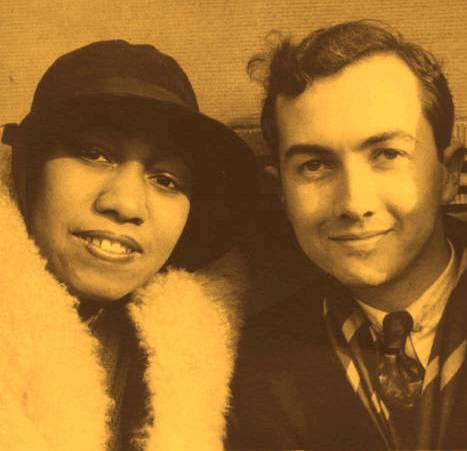Gladys Bentley: August 12, 1907–January 18, 1960
Gladys Bentley (August 12, 1907 – January 18, 1960) was a United States blues singer prominent during the Harlem Renaissance of the 1920s and 1930s.
Gladys Bentley and artist Prentiss Taylor, about 1935.
Biography
Bentley was born in Philadelphia, Pennsylvania, the daughter of American George L. Bentley and his wife, a Trinidadian, Mary Mote.[1]
Gladys Bentley appeared at Harry Hansberry's "Clam House" on 133rd Street, one of New York City's most notorious gay speakeasies,[2]
In the 1920s and early thirties Bentley headlined at Harlem's Ubangi Club, where she was backed up by a chorus line of drag queens.
She was a 250 pound woman dressed in men's clothes (including a signature tuxedo and top hat), who played piano and sang her own raunchy lyrics to popular tunes of the day in a deep, growling voice while flirting outrageously with women in the audience.
On the decline of the Harlem speakeasies with the repeal of Prohibition, she relocated to southern California, where she was billed as "America's Greatest Sepia Piano Player", and the "Brown Bomber of Sophisticated Songs". She was frequently harassed for wearing men's clothing. She claimed that she had married a white woman in Atlantic City.
Bentley was openly lesbian during her early career,[3].
But during the McCarthy Era of the late-1940s and early-1950s, she started wearing dresses, married a man (who later denied that they ever married), and studied to be a minister, claiming to have been "cured" by taking female hormones.[4]
She died, aged 52, from pneumonia in 1960.
Fictional characters based on Bentley appeared in Carl Van Vechten's Parties, Clement Woods' novel Deep River, and Blair Niles's novel Strange Brother. She recorded for the OKeh company, Victor Records, Excelsior, and Flame.
Venues
Gladys Bentley appeared at:
- Clam House - New York
- Ubangi Club - New York
- Joquins' El Rancho - Los Angeles
- Mona's Club 440 - San Francisco
References
- ↑ Adapted from Wikipedia, accessed February 13, 2011.
- ↑ Garber, Eric. "A Spectacle in Color: The Lesbian and Gay Subculture of Jazz Age Harlem.
- ↑ Gillian Rodger. "Gladys Bentley". glbtq.com at http://www.glbtq.com/arts/bentley_g.html
- ↑ QueerCulturalCenter.org. "Gladys Bentley" at http://www.queerculturalcenter.org/Pages/Bentley/BentleyBio.html from Garber, in Hidden from History, ed. by Martin Duberman, Martha Vicinus, and George Chauncey. 1990. Penguin. ISBN: 0452010675
